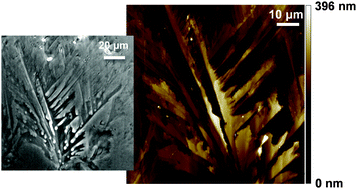Hierarchical self-assembly of di-, tri- and tetraphenylalanine peptides capped with two fluorenyl functionalities: from polymorphs to dendrites†
Abstract
Homopeptides with 2, 3 and 4 phenylalanine (Phe) residues and capped with fluorenylmethoxycarbonyl and fluorenylmethyl esters at the N-terminus and C-terminus, respectively, have been synthesized to examine their self-assembly capabilities. Depending on the conditions, the di- and triphenylalanine derivatives self-organize into a wide variety of stable polymorphic structures, which have been characterized: stacked braids, doughnut-like shapes, bundled arrays of nanotubes, corkscrew-like shapes and spherulitic microstructures. These highly aromatic Phe-based peptides also form incipient branched dendritic microstructures, even though they are highly unstable, making their manipulation very difficult. Conversely, the tetraphenylalanine derivative spontaneously self-assembles into stable dendritic microarchitectures made of branches growing from nucleated primary frameworks. The fractal dimension of these microstructures is ∼1.70, which provides evidence for self-similarity and two-dimensional diffusion controlled growth. DFT calculations at the M06L/6-31G(d) level have been carried out on model β-sheets since this is the most elementary building block of Phe-based peptide polymorphs. The results indicate that the antiparallel β-sheet is more stable than the parallel one, with the difference between them growing with the number of Phe residues. Thus, the cooperative effects associated with the antiparallel disposition become more favorable when the number of Phe residues increases from 2 to 4, while those of the parallel disposition remained practically constant.


 Please wait while we load your content...
Please wait while we load your content...